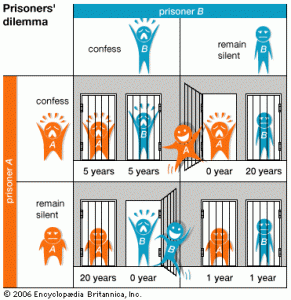Pawel Brodzinski opened an interesting discussion about why executive management seems to be disconnected. I responded with my previous post and both
Pawel and
Josh responded. My perspective of why executive
management seems
detached is different from theirs, because I believe we approach the whole topic from different philosophical perspectives. In my last post, I outlined management from the ground up. This time I'll set my contextual perspective and then describe management from the top down.
Why Businesses Came into Existence
My outlook on business derives from why businesses first appeared and why they were structured the way they were. The modern corporation came started in Britain in the early seventeenth century, when wealthy, land owning nobleman realized that if they gave up a portion of their capital and entrusted it to an organized group of intelligent, motivated and hungry workers, they could make themselves much wealthier. However, to make sure that these workers didn't run off with their money, they set up structures and oversight and put two or three of their own people, the executives, in charge of running their businesses.
The CEO, CFO and Chief Legal Council could be put in and with little background experience in the particulars of the business, they could ensure capital was effectively deployed, dividends were paid. They did not have to know the working details in order to effectively manage it.
Few businesses had over 500 people and with three people, the business structures were created so that skills and goals could be organized into departments to make the work most effective. The people in those departments (operations, sales, accounting etc.) needed to know the details of their area, but those people could be promoted from within the ranks.
So Why Do You Say Executives Are Different? (Degree of Separation One)
An executive's responsibility is to people outside the business. Whether it's Board Meetings, sitting on Boards of other companies to create synergies, conducting financial analyst conference calls, meeting with bankers or participating in closing large sales; their focus is external to the business. When they allocate their time, depending upon the type of business, 30 to 60% of their time is devoted to people external to the business.
The Importance of Structures (Degree of Separation Two)
This is as it should be. Within departments, there are managers, usually several layers of them. One problem with setting up structures is that if you don't respect the structure, you render it useless. As an executive, if you say something to someone at a lower level in the business that contradicts what their manager has told them, you have rendered the structure ineffective.
The difficulty for an executive is that they don't know what mid level managers have said. They can't check with them every time someone asks them a question. So what are they going to do? Either, they limit access to pleasantries in the hallway and large company events or they find themselves pulled into the quicksand of internal management that they are paying mid-level managers to do. Additionally, they then cannot focus 30 to 60% of their time to parties external to the business that need attention if the business is going to continue to grow.
Where They Come From (Degree of Separation Three)
It's a taboo subject, but there are classes in the US. Historically, less than 20% of the population went to university. A university degree from an elite institution was a clear socioeconomic indicator. Even though the number of people going to university has increased tremendously, your college degree still largely determines who you'll work with, who your friends will be and the jobs you'll take.
If you graduate from Yale or Harvard or Princeton or Stanford, you'll enter the business world in a way and level that will determine much of your future career. If you graduate from a state university, that will also determine the way, level and expectations people will hold of you.
Very few people start in the proverbial mail room and work their way up to executive. I'm not saying that it never happens, but it is pointed out as news when it happens specifically because it is so uncommon.
Those are three degrees of separation that make executives seem distant. They have different responsibilities, different structural concerns and different background and expectations.
This is why I think inquiries into alignment are so interesting.
 I grew up in a rural area. Rural enough that dogs chased cars. Extraordinarily enough, the dogs never caught the cars. In fact, they never got close. It was good sport. The dog felt very fulfilled, barked aggressively and made sure to never come close to catching the car. As best as I can recall, the car was never affected by the ordeal.
I grew up in a rural area. Rural enough that dogs chased cars. Extraordinarily enough, the dogs never caught the cars. In fact, they never got close. It was good sport. The dog felt very fulfilled, barked aggressively and made sure to never come close to catching the car. As best as I can recall, the car was never affected by the ordeal. Have you ever been on a project or program where all the PMs knew that their project was in trouble, but they were waiting for someone else to admit their problems first? It happens often enough, as soon as one PM admits that they have a problem, everyone else discovers problems too.
Have you ever been on a project or program where all the PMs knew that their project was in trouble, but they were waiting for someone else to admit their problems first? It happens often enough, as soon as one PM admits that they have a problem, everyone else discovers problems too.
 When Project Managers and others work on projects, they often consider themselves enlightened seekers. People seeking new and better ways to do things. They are often frustrated by those not eagerly embracing the changes. Let's call them dwarfs; people who are not on a journey, but who have the knowledge and almost magical power to make a project succeed or fail. Dwarfs are often more critical to the success of the project than the seeker or anyone else might expect. I contend that to succeed, you have to be both. Sometimes you need seekers and sometimes you need dwarfs.
When Project Managers and others work on projects, they often consider themselves enlightened seekers. People seeking new and better ways to do things. They are often frustrated by those not eagerly embracing the changes. Let's call them dwarfs; people who are not on a journey, but who have the knowledge and almost magical power to make a project succeed or fail. Dwarfs are often more critical to the success of the project than the seeker or anyone else might expect. I contend that to succeed, you have to be both. Sometimes you need seekers and sometimes you need dwarfs.








